Thermal Energy Transfer
Mastering Thermal Energy Transfer in Refrigerant-Based Heat Pumps

In our quest to excel at transferring thermal energy, we explore the complex realm of heat pumps that use refrigerants.
By understanding the complexities of heat transfer mechanisms and the vital role of refrigerants, we unlock the potential for optimal performance and efficiency.
Join us as we explore advanced techniques and strategies for controlling heat transfer in these systems, ultimately aiming to serve you better by maximizing heat exchange efficiency and overcoming challenges in the realm of thermal energy transfer.
Key Takeaways
- Heat pumps extract heat from a low-temperature source and transfer it to a higher-temperature sink.
- Refrigerants act as working fluids in heat pumps, absorbing and releasing heat during the refrigeration cycle.
- Efficient heat transfer is crucial for optimal energy transfer and improved overall system performance.
- High-efficiency heat exchangers play a crucial role in maximizing heat exchange efficiency.
The Basics of Thermal Energy Transfer in Heat Pumps
Understanding heat pump operation is crucial in comprehending how thermal energy is transferred in these systems. Heat pumps work by extracting heat from a low-temperature source and transferring it to a higher-temperature sink. This process is facilitated by a refrigerant, which undergoes a cycle of evaporation and condensation. The refrigerant absorbs heat from the source when it evaporates, and releases heat when it condenses.

Insulation plays a vital role in thermal energy transfer, as it reduces heat loss or gain during the process. By minimizing heat transfer to the surroundings, insulation improves the efficiency of heat pumps. It’s essential to choose insulation materials carefully, ensuring they’ve low thermal conductivity to maximize energy savings and maintain optimal temperature control.
Understanding the Role of Refrigerants in Heat Pump Systems
We can gain a better understanding of the role of refrigerants in heat pump systems by examining their chemical properties and heat transfer characteristics. Refrigerants play a crucial role in the operation and efficiency of heat pumps. The selection of the right refrigerant is essential for maximizing heat pump performance and improving overall energy efficiency.
Refrigerants act as the working fluid in heat pumps, absorbing and releasing heat during the refrigeration cycle. They undergo phase changes from a low-pressure vapor to a high-pressure liquid, allowing for efficient heat transfer. The chemical properties of refrigerants, such as their boiling point and specific heat capacity, determine their ability to absorb and release heat.
Choosing the appropriate refrigerant involves considering factors such as environmental impact, safety, and thermodynamic properties. The goal is to find a refrigerant that has a low global warming potential (GWP) and ozone depletion potential (ODP), while also providing high energy efficiency. Advancements in refrigerant technology have led to the development of environmentally friendly options that can significantly improve heat pump efficiency.

The Importance of Efficient Heat Transfer in Refrigerant-Based Heat Pumps
Efficient heat transfer is of paramount importance in refrigerant-based heat pumps. Enhancing heat exchange efficiency allows for optimal energy transfer, resulting in improved overall system performance.
Enhancing Heat Exchange Efficiency
To optimize the performance of refrigerant-based heat pumps, it’s crucial to enhance heat exchange efficiency through efficient heat transfer. Maximizing heat exchange efficiency is essential in ensuring that the heat pump operates at its highest potential, delivering the desired heating or cooling effect with minimal energy consumption. Improving heat transfer techniques can greatly contribute to achieving this goal.
Here are five key approaches that can enhance heat exchange efficiency:
- Utilizing advanced heat exchanger designs
- Enhancing refrigerant flow characteristics
- Optimizing surface area for heat transfer
- Minimizing thermal resistance through effective insulation
- Incorporating smart control systems for precise temperature regulation
Optimizing Energy Transfer
The efficient energy transfer in refrigerant-based heat pumps is of utmost importance in optimizing their performance. By maximizing efficiency and reducing energy consumption, we can ensure that these heat pumps operate at their highest potential, providing reliable and cost-effective heating and cooling solutions. To emphasize the significance of efficient energy transfer, let us consider the following table:
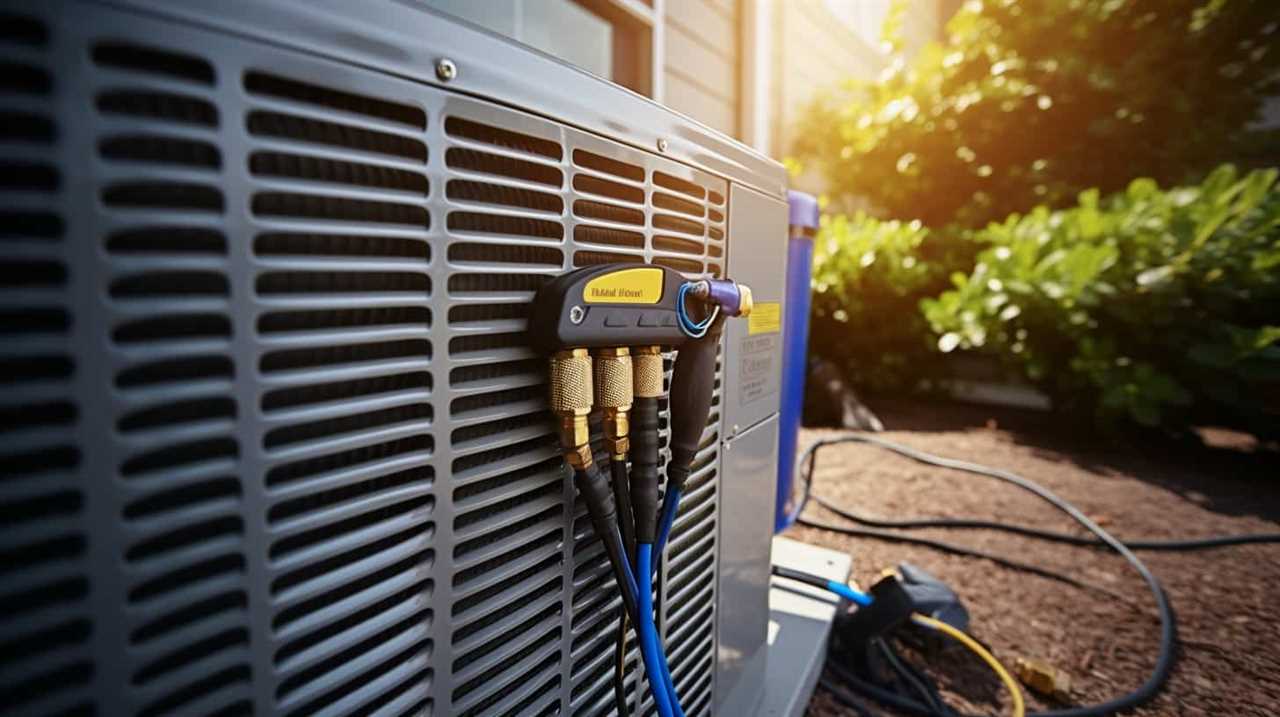
| Factors Affecting Energy Transfer | Impact on Efficiency |
|---|---|
| Proper insulation | High |
| Correct refrigerant charge | High |
| Clean and well-maintained coils | High |
| Optimal airflow | High |
| Proper sizing of equipment | High |
As seen in the table, each factor plays a crucial role in maximizing the efficiency of energy transfer in refrigerant-based heat pumps. By paying attention to these aspects, we can achieve significant energy savings and ensure the best performance from these systems.
Exploring Different Heat Transfer Mechanisms in Heat Pumps
We have identified various heat transfer mechanisms that play a crucial role in the operation of heat pumps. Exploring different heat transfer mechanisms is essential for improving heat transfer performance and optimizing energy efficiency in heat pump designs.
Here are some of the mechanisms we’ve examined:
- Conduction: Heat transfer through direct contact between materials.
- Convection: Heat transfer through the movement of fluids, such as air or water.
- Radiation: Heat transfer through electromagnetic waves.
- Phase change: Heat transfer during the transition between different states of matter, such as liquid to gas or solid to liquid.
- Heat exchangers: Devices that facilitate heat transfer between two fluids without direct contact.
Maximizing Heat Exchange Efficiency in Refrigerant-Based Heat Pumps
To maximize heat exchange efficiency in refrigerant-based heat pumps, we need to focus on three key points.

First, optimal heat transfer techniques should be employed to ensure efficient transfer of thermal energy between the refrigerant and the surrounding environment. This can be achieved through the use of high-performance heat exchangers and advanced heat transfer surfaces.
Second, enhancing refrigerant circulation is crucial to improve heat exchange efficiency. This can be achieved by optimizing the design of the refrigerant circuitry and using efficient pumps or compressors.
Lastly, minimizing energy loss is essential to maximize heat exchange efficiency. This can be achieved by reducing heat leakage through insulation, minimizing pressure drops in the system, and utilizing energy recovery techniques.
Optimal Heat Transfer Techniques
Our focus is on maximizing the heat exchange efficiency in refrigerant-based heat pumps by implementing optimal heat transfer techniques. To achieve this goal, we need to carefully balance temperature gradients and utilize advanced heat transfer techniques.
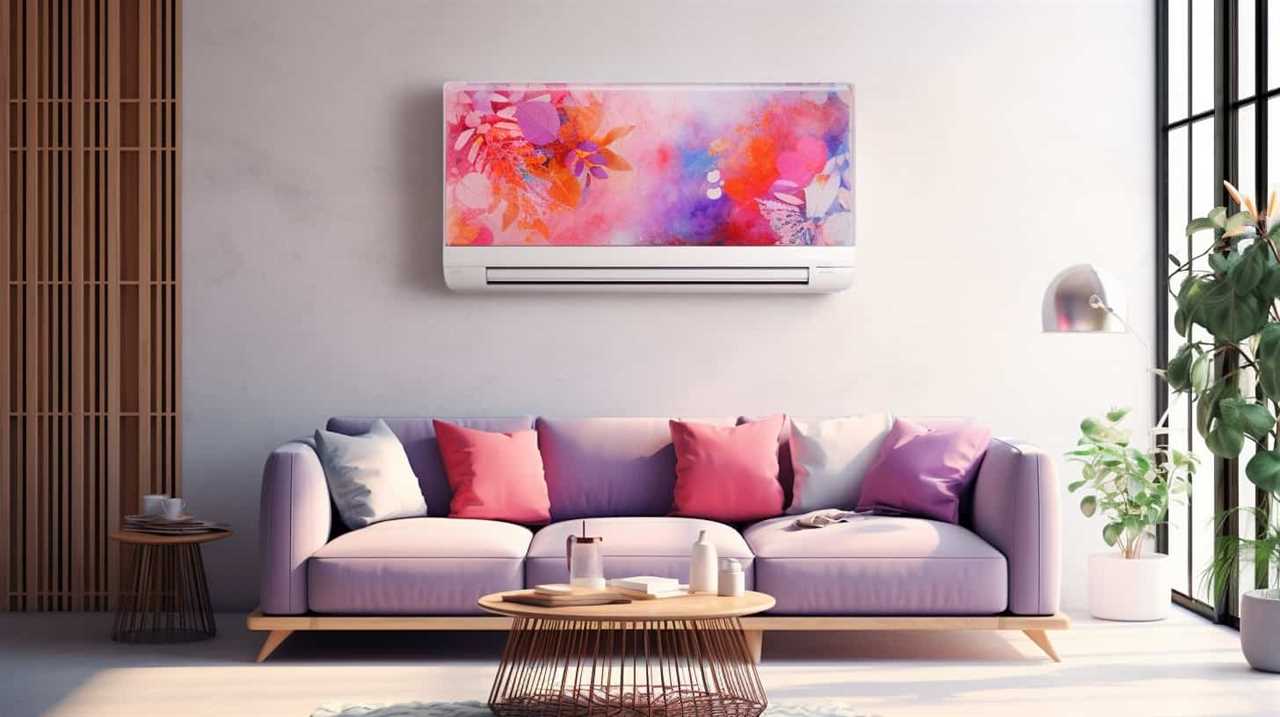
Here are five key strategies to consider:
-
Enhancing surface area: Increasing the contact area between the refrigerant and the surrounding environment improves heat transfer efficiency.
-
Improving fluid flow: Optimizing the flow rate and direction of the refrigerant enhances convective heat transfer, leading to improved efficiency.
-
Utilizing heat exchangers: Incorporating heat exchangers allows for effective transfer of heat between the refrigerant and the desired heating or cooling medium.

-
Enhancing insulation: Minimizing heat loss through proper insulation helps maintain temperature differentials and improves overall efficiency.
-
Utilizing phase change: Taking advantage of phase change phenomena, such as condensation and evaporation, can significantly enhance heat transfer efficiency.
Enhancing Refrigerant Circulation
Enhancing refrigerant circulation is crucial for maximizing the heat exchange efficiency in refrigerant-based heat pumps. By improving refrigerant flow, we can increase the rate at which heat is transferred and ensure optimal performance of the system.
One way to maximize circulation efficiency is by optimizing the design of the heat exchangers. This involves selecting the right size and type of tubes, fins, and flow channels to promote efficient heat transfer.

Additionally, proper refrigerant charge and pressure levels are essential for maintaining a balanced flow and preventing any restrictions or blockages within the system. Regular maintenance, such as cleaning or replacing filters and checking for leaks, is also necessary to ensure smooth refrigerant flow.
By focusing on enhancing refrigerant circulation, we can significantly improve the heat exchange efficiency of refrigerant-based heat pumps.
To minimize energy loss and further optimize the system, we’ll now discuss the next subtopic: ‘Minimizing Energy Loss’.
Minimizing Energy Loss
By implementing strategies to minimize energy loss, we can effectively maximize the heat exchange efficiency in refrigerant-based heat pumps. To achieve this goal, we should focus on balancing temperature differentials and utilizing advanced heat transfer techniques.

Here are five key strategies to minimize energy loss and improve efficiency:
-
Optimize insulation: Ensuring proper insulation around the system components reduces heat loss and increases overall efficiency.
-
Enhance sealing: By sealing any air leaks in the system, we can prevent energy loss and maintain optimal performance.
-
Improve refrigerant flow control: Implementing efficient flow control mechanisms helps to regulate the refrigerant flow and minimize energy wastage.

-
Enhance heat exchanger design: Utilizing advanced heat exchanger designs improves heat transfer efficiency and reduces energy loss.
-
Regular maintenance: Conducting regular inspections and maintenance activities ensures that the system operates at its peak performance and minimizes energy loss.
Optimizing the Design of Heat Exchangers for Enhanced Energy Transfer
We can optimize the design of heat exchangers to enhance energy transfer in refrigerant-based heat pumps. Maximizing energy efficiency is crucial in these systems, and heat exchanger design improvements play a significant role in achieving this goal.
One way to enhance energy transfer in heat exchangers is by increasing the surface area available for heat exchange. This can be achieved through various means, such as using finned tubes or incorporating extended surfaces. By increasing the surface area, the heat exchanger can extract more heat from the refrigerant, maximizing energy transfer and improving system performance.
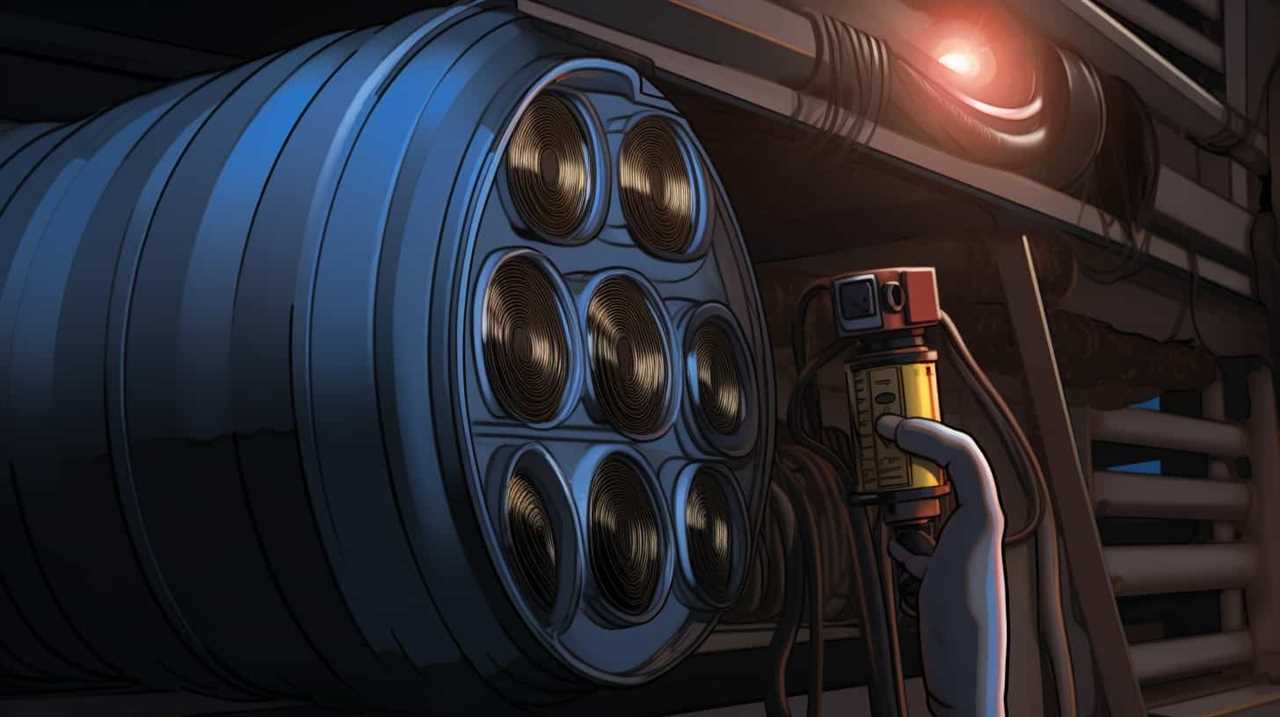
Another important aspect of heat exchanger design is optimizing the flow pattern of the refrigerant. By carefully designing the flow path, we can ensure that the refrigerant makes efficient contact with the heat transfer surfaces, facilitating effective heat transfer and minimizing energy loss.
Additionally, selecting the appropriate materials for heat exchanger construction is crucial. Materials with high thermal conductivity and corrosion resistance can enhance energy transfer while ensuring the longevity and reliability of the heat exchanger.
Strategies for Minimizing Heat Loss in Refrigerant-Based Heat Pumps
To minimize heat loss in refrigerant-based heat pumps, we can employ two main strategies: insulation and sealing. These strategies are crucial for improving the overall efficiency and performance of heat pump systems.
Here are five specific ways to minimize heat loss and improve insulation:
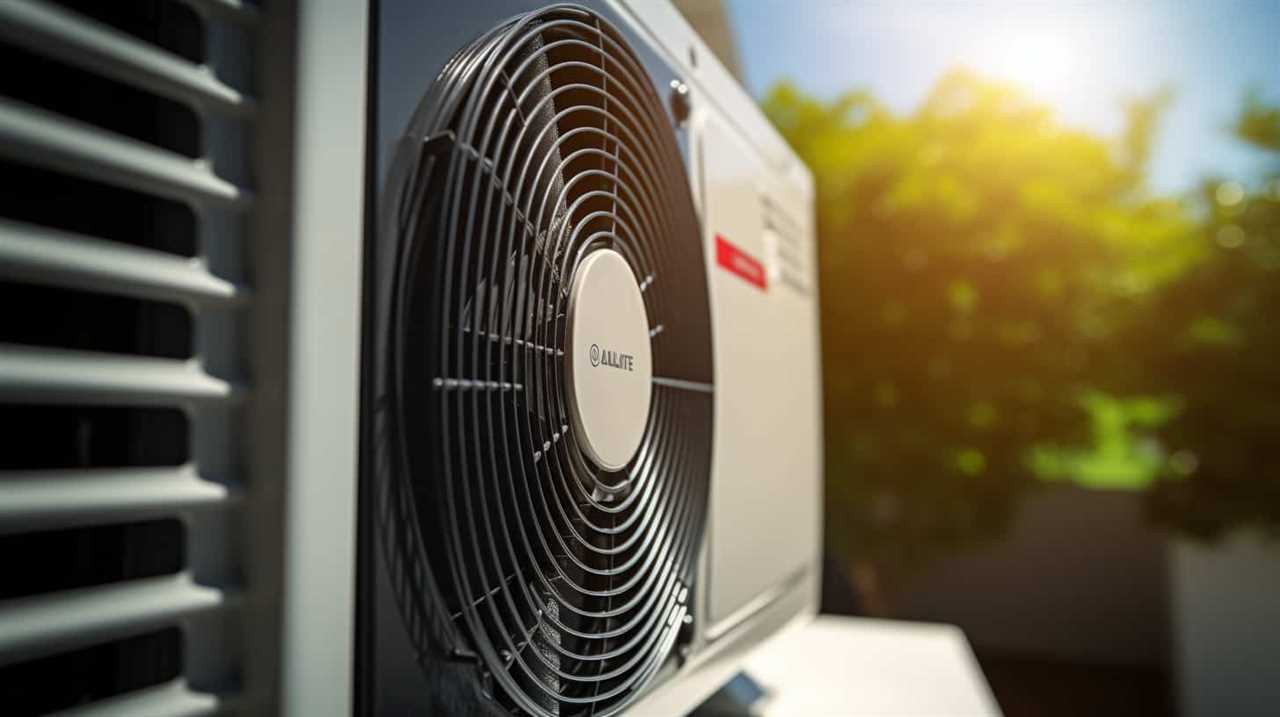
- Properly insulating the refrigerant lines and components to reduce heat transfer between the system and its surroundings.
- Using high-quality insulation materials with low thermal conductivity to prevent heat loss.
- Ensuring a tight seal between different components and connections to prevent air leakage and heat transfer.
- Installing insulation blankets or jackets around heat exchangers and other critical components to minimize heat loss.
- Regularly inspecting and maintaining the insulation system to identify and address any issues that may compromise its effectiveness.
By implementing these strategies, we can significantly reduce heat loss in refrigerant-based heat pumps, leading to improved energy efficiency and cost savings.
Now, let’s delve into the next section, which discusses the importance of balancing heat transfer rates for optimal performance in heat pump systems.
Balancing Heat Transfer Rates for Optimal Performance in Heat Pump Systems
To achieve optimal performance in heat pump systems, it’s crucial to balance heat transfer rates. This involves considering factors such as heat pump efficiency and the balancing of temperature differentials.
Heat Pump Efficiency
Achieving optimal performance in heat pump systems involves balancing the rates of heat transfer to maximize efficiency. To ensure the heat pump operates at its highest efficiency, it’s important to focus on heat pump maintenance and implement energy-saving tips.

Here are some key strategies to consider:
- Regularly clean and replace air filters to optimize airflow and reduce energy consumption.
- Schedule annual professional maintenance to check for refrigerant leaks, clean coils, and ensure proper system operation.
- Install a programmable thermostat to regulate temperature settings and reduce energy usage when the space is unoccupied.
- Properly insulate the ductwork to minimize heat loss and improve overall system efficiency.
- Consider using a heat pump cover during colder months to protect the outdoor unit and prevent ice buildup.
Optimal Heat Transfer
The key to achieving optimal performance in heat pump systems is balancing the rates of heat transfer for maximum efficiency. Heat transfer optimization plays a crucial role in maximizing efficiency and ensuring the smooth operation of heat pump systems. By carefully managing the flow of thermal energy, we can minimize energy losses and enhance the overall performance of the system. To illustrate the importance of heat transfer optimization, consider the following table:
| Heat Transfer Component | Purpose | Optimization Techniques |
|---|---|---|
| Evaporator | Absorbs heat from the surroundings | Increasing surface area, improving refrigerant flow |
| Condenser | Releases heat to the surroundings | Enhancing airflow, optimizing refrigerant flow rate |
| Compressor | Increases the temperature and pressure of the refrigerant | Minimizing pressure drop, optimizing compressor speed |
Balancing Temperature Differentials?
We can achieve optimal performance in heat pump systems by balancing the temperature differentials and heat transfer rates. Balancing temperature regulation and improving thermal efficiency are essential for maximizing the performance of heat pump systems. Here are five key considerations to achieve this balance:
- Properly sizing the heat pump system to match the heating or cooling load requirements.
- Adjusting the temperature set points to optimize the temperature differentials between the heat source and the heat sink.
- Ensuring proper insulation and sealing to minimize heat loss or gain.
- Regular maintenance and cleaning of the heat pump components to ensure efficient operation.
- Implementing advanced control algorithms and sensors to monitor and adjust the heat transfer rates based on real-time conditions.
Overcoming Challenges in Thermal Energy Transfer for Improved Heat Pump Efficiency
To enhance heat pump efficiency, we must address the challenges associated with thermal energy transfer. Overcoming heat pump limitations is crucial in achieving optimal performance. One way to tackle this is through the use of innovative heat transfer techniques.
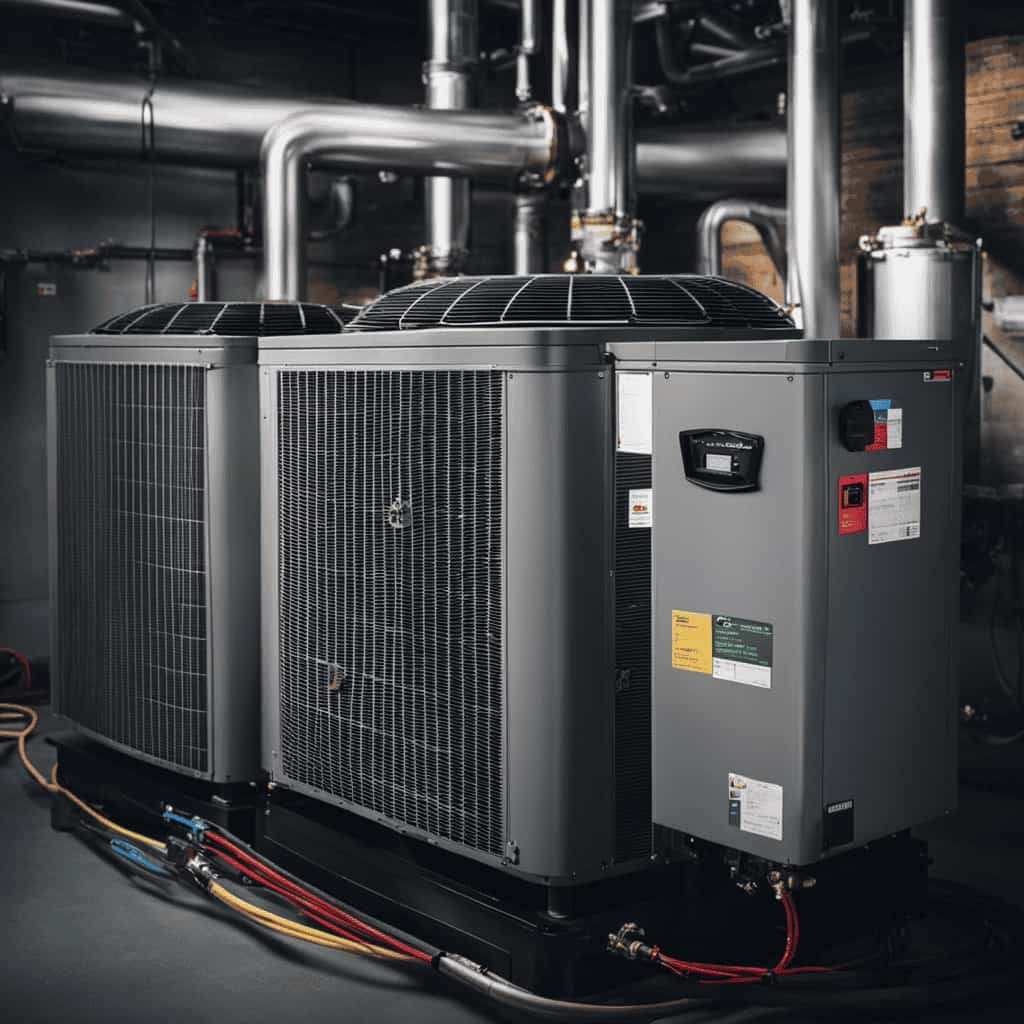
These techniques aim to minimize energy losses during the transfer process and maximize the amount of heat that can be extracted or delivered. By employing advanced heat exchangers with enhanced surface areas and optimized flow patterns, we can improve the overall heat transfer efficiency of the system.
Additionally, the implementation of intelligent control systems can help optimize the operation of the heat pump, ensuring that it operates at its highest efficiency levels under varying conditions. These advancements in thermal energy transfer techniques pave the way for improved heat pump efficiency and performance.
Now, let’s delve into the next section to explore advanced techniques for controlling heat transfer in refrigerant-based heat pumps.
Advanced Techniques for Controlling Heat Transfer in Refrigerant-Based Heat Pumps
How can we effectively control heat transfer in refrigerant-based heat pumps using advanced techniques? Optimizing heat transfer efficiency is crucial in improving the overall performance of heat pumps.
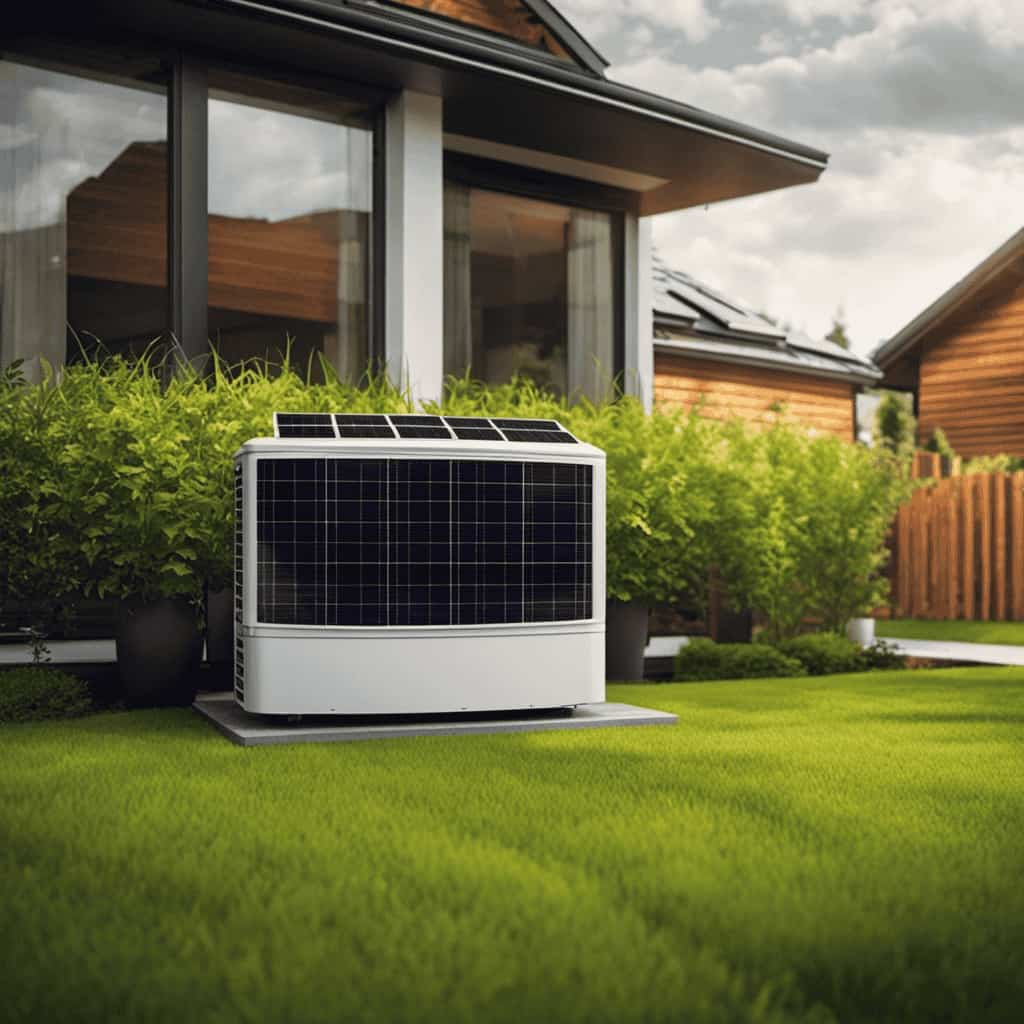
Here are some advanced techniques for heat pump control:
- Variable-speed compressors: These allow for precise control of refrigerant flow, matching the system’s cooling or heating demand.
- Electronic expansion valves: These valves adjust the refrigerant flow rate, ensuring optimal heat transfer and system efficiency.
- Heat exchanger design: Advanced heat exchanger designs, such as microchannel or plate heat exchangers, enhance heat transfer by increasing surface area and reducing refrigerant pressure drop.
- Intelligent control algorithms: Utilizing advanced algorithms, heat pumps can dynamically adjust operating parameters based on environmental conditions, maximizing energy efficiency.
- Integrated sensors and feedback systems: By integrating sensors and feedback systems, heat pumps can continuously monitor and optimize heat transfer performance in real-time.
Implementing these advanced techniques can significantly enhance heat pump performance, leading to improved energy efficiency, reduced operating costs, and increased customer satisfaction.
Mastering the Art of Heat Transfer Management in Heat Pump Applications
Proper management of heat transfer is essential in maximizing the efficiency and performance of heat pump applications. To achieve this, we must focus on innovative heat transfer solutions that can effectively transfer thermal energy between the heat source and the heat sink.
One such solution is the use of advanced heat exchangers that optimize the heat transfer process. These heat exchangers are designed to maximize the surface area available for heat exchange, resulting in improved thermal performance.

Additionally, the use of enhanced heat transfer fluids can further enhance the heat transfer process by increasing the overall heat transfer coefficient.
Frequently Asked Questions
What Are the Different Types of Heat Pumps Available on the Market?
There are several types of heat pumps available on the market. They vary in terms of installation, operating costs, and efficiency. It’s important to consider these factors when choosing the right heat pump for your needs.
How Does the Choice of Refrigerant Impact the Efficiency of a Heat Pump?
Refrigerant selection plays a crucial role in determining the energy efficiency of a heat pump. Different refrigerants have varying thermodynamic properties that affect the heat transfer process, ultimately impacting the overall efficiency of the system.
What Are Some Common Challenges Faced in Maximizing Heat Exchange Efficiency in Refrigerant-Based Heat Pumps?
Challenges in maximizing heat exchange efficiency in refrigerant-based heat pumps are numerous. Strategies include optimizing the design of heat exchangers, reducing thermal losses, and improving refrigerant properties. These efforts are essential for efficient and sustainable energy transfer.

What Are the Key Factors to Consider When Designing Heat Exchangers for Enhanced Energy Transfer in Heat Pumps?
When designing heat exchangers for enhanced energy transfer in heat pumps, key factors to consider include design considerations and performance optimization. These factors are crucial in maximizing heat exchange efficiency and improving overall system performance.
Are There Any Advanced Techniques or Technologies Available for Improving Heat Transfer in Refrigerant-Based Heat Pumps?
Yes, there are advanced techniques and technologies available for improving heat transfer in refrigerant-based heat pumps. These advancements focus on enhancing thermal energy transfer, optimizing heat exchange methods, and improving heat transfer efficiency.
Conclusion
In our quest to master thermal energy transfer in refrigerant-based heat pumps, we’ve delved into the intricacies of heat exchange mechanisms and efficient heat transfer.
By balancing heat transfer rates and overcoming challenges, we can achieve optimal performance and improved efficiency in heat pump systems.

Through advanced techniques and precise heat transfer management, we can unlock the true potential of heat pump applications, paving the way for a future where thermal energy is harnessed with mastery and finesse.
Thermal Energy Transfer
Boost Heat Pump Efficiency: Renewable Energy’s Unexpected Power

Are you prepared to unleash the complete capabilities of your heat pump? Search no more! In this article, we will delve into the surprising impact of renewable energy on enhancing heat pump effectiveness.
Get ready to revolutionize your heating system as we delve into the role of solar energy, harnessing geothermal power, the game-changing wind energy, sustainable biomass solutions, and the untapped potential of hydropower.
Prepare to master the art of maximizing heat pump performance with the help of renewable energy sources.
Key Takeaways
- Solar panel integration allows for the direct conversion of sunlight into electricity, reducing reliance on traditional power sources.
- Geothermal energy can maximize heat pump performance by providing heat stored beneath the Earth’s surface, leading to higher levels of efficiency.
- Wind power can revolutionize heat pump efficiency by generating electricity to power heat pumps, reducing their carbon footprint.
- Biomass combined with heat pump technology greatly enhances efficiency and sustainability, reducing reliance on fossil fuels and emitting fewer greenhouse gases.
The Role of Solar Energy in Enhancing Heat Pump Efficiency
We can enhance heat pump efficiency by utilizing solar energy. Solar panel integration plays a crucial role in harnessing renewable energy for heat pumps. By connecting solar panels to heat pump systems, we can directly convert sunlight into electricity, reducing reliance on traditional power sources. This integration allows heat pumps to operate more efficiently, as they can draw power from the solar panels during daylight hours.

Additionally, energy storage solutions can further optimize heat pump performance. Storing excess solar energy in batteries or other storage systems ensures a continuous power supply for heat pumps, even when sunlight is limited.
This combination of solar panel integration and energy storage solutions maximizes the utilization of renewable energy, significantly improving heat pump efficiency.
Harnessing Geothermal Power to Maximize Heat Pump Performance
One way to maximize heat pump performance is by harnessing the power of geothermal energy. Geothermal energy is heat that is stored beneath the Earth’s surface in geothermal reservoirs. This heat can be extracted and used to provide heating and cooling for buildings. Geothermal innovations have made it possible to tap into this renewable energy source and optimize the efficiency of heat pumps.
By utilizing geothermal energy, heat pumps can achieve higher levels of efficiency compared to traditional heating and cooling systems. The table below illustrates the advantages of harnessing geothermal power for heat pump performance:
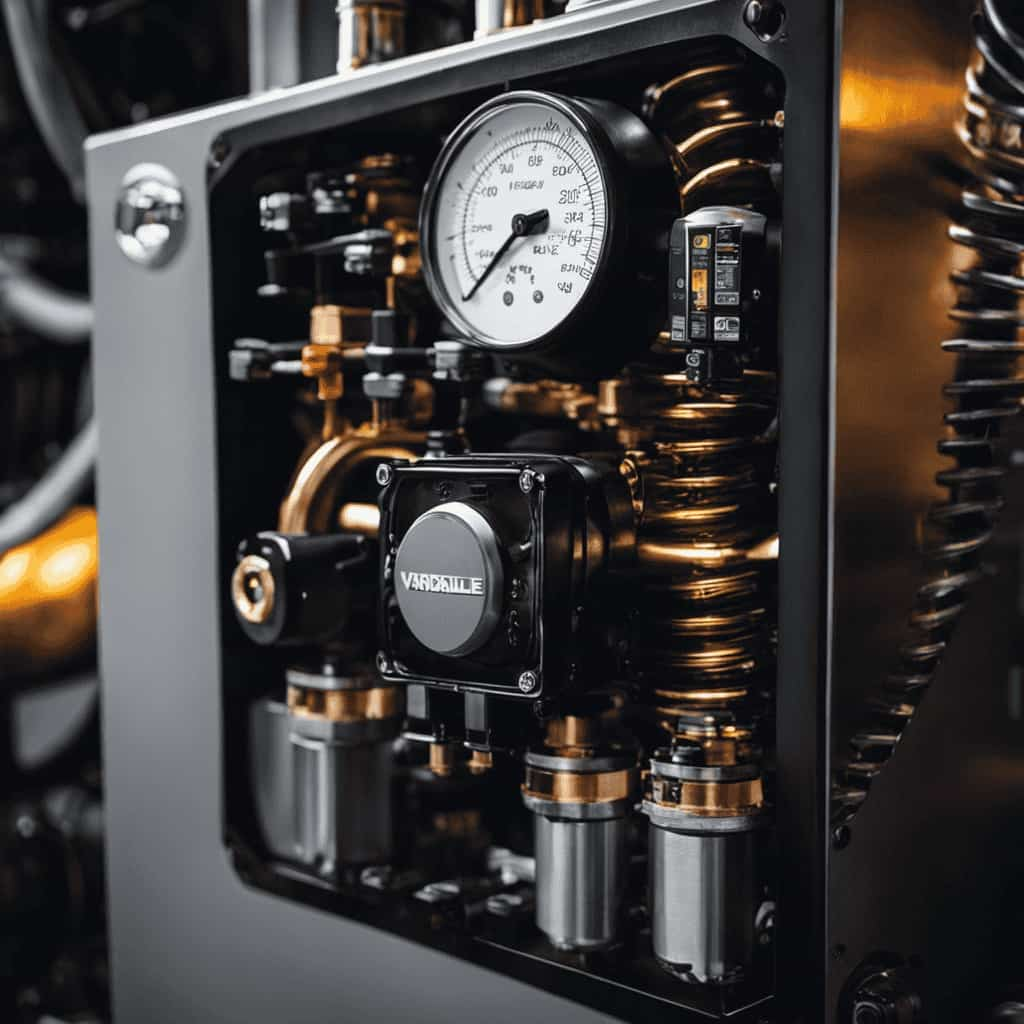
| Advantages of Geothermal Power for Heat Pump Performance |
|---|
| Higher efficiency |
| Reduced energy consumption |
| Lower operating costs |
| Environmentally friendly |
Harnessing geothermal power not only improves the performance of heat pumps but also contributes to a more sustainable and energy-efficient future. By utilizing the abundant geothermal resources available, we can maximize the efficiency of heat pumps and reduce our carbon footprint.
Wind Energy: A Game-Changer for Heat Pump Efficiency
Harnessing wind energy can revolutionize heat pump efficiency.
Wind energy has the potential to be a game changer for heat pump technology, offering significant benefits to renewable energy solutions.
By utilizing wind power to generate electricity, heat pumps can operate more efficiently and reduce their carbon footprint.

Wind turbines can produce large amounts of electricity, which can be used to power heat pumps, allowing them to operate at higher efficiencies.
Additionally, wind energy is a clean and renewable source, making it an environmentally friendly option for heat pump systems.
The integration of wind energy into heat pump technology enhances the overall performance and sustainability of these systems.
Biomass: A Sustainable Solution for Boosting Heat Pump Efficiency
Using biomass as a renewable fuel source and combining it with heat pump technology can greatly enhance efficiency and sustainability. Biomass, which refers to organic materials such as wood, agricultural residues, and dedicated energy crops, offers a promising alternative fuel for heat pumps. By harnessing the energy stored in biomass, heat pumps can provide a reliable and efficient heating solution while reducing reliance on fossil fuels. The innovative combination of biomass and heat pump technology allows for a more sustainable heating system that emits fewer greenhouse gases and decreases overall energy consumption. To illustrate the potential benefits of this approach, consider the table below, which compares the energy efficiency and carbon emissions of biomass-powered heat pumps to conventional heating systems.
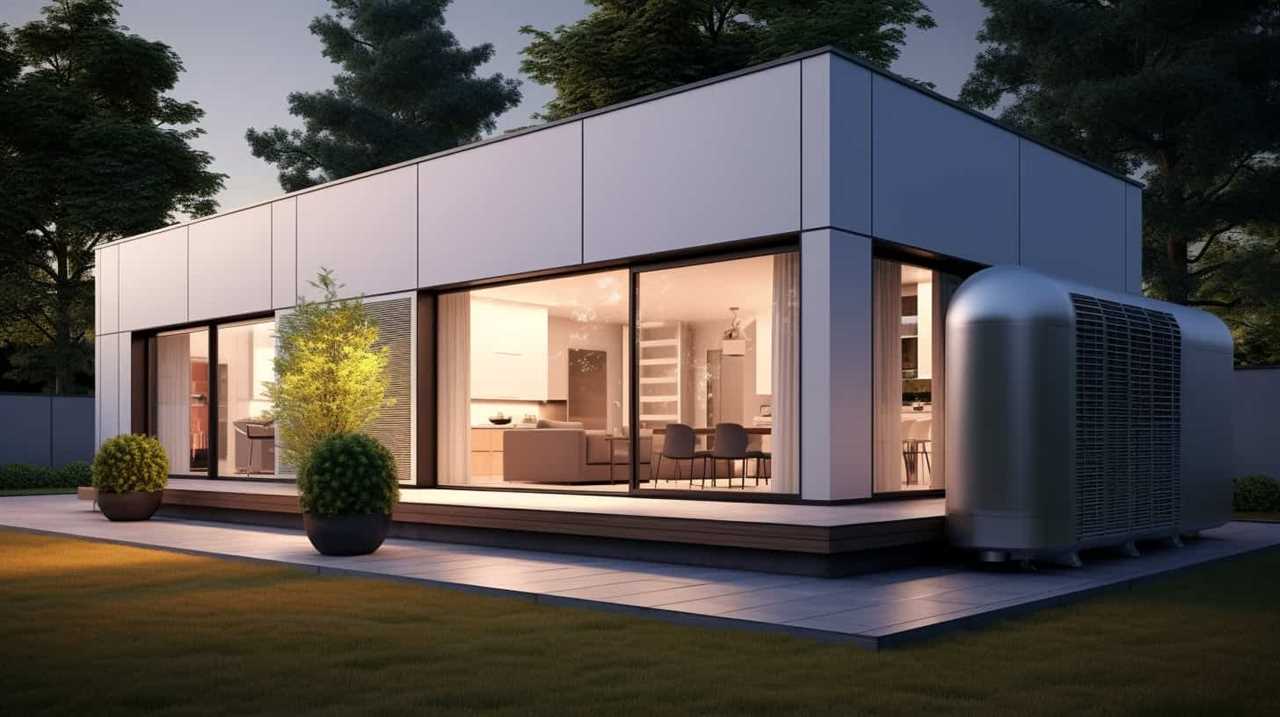
| Heating System | Energy Efficiency (COP) | Carbon Emissions (kgCO2/MWh) |
|---|---|---|
| Biomass Heat Pump | 4.5 | 10 |
| Natural Gas Boiler | 0.9 | 200 |
| Oil Boiler | 0.85 | 250 |
| Electric Resistance | 1 | 500 |
| Air-Source Heat Pump | 3 | 60 |
As shown in the table, biomass heat pumps have a significantly higher energy efficiency and lower carbon emissions compared to other heating systems. This makes them an attractive and sustainable solution for boosting heat pump efficiency.
Hydropower: Unleashing the Potential of Water to Improve Heat Pump Performance
We can maximize heat pump performance by tapping into the immense potential of hydropower, using water as a renewable energy source. Hydropower, also known as hydroelectric power, offers several advantages in improving heat pump efficiency.
- Water Efficiency:
- Hydropower utilizes the natural flow of water, harnessing its kinetic energy to generate electricity.
- This process doesn’t consume water, making it a highly water-efficient energy source.
- Heat pumps can benefit from this water efficiency by leveraging hydropower for their operations, reducing overall water consumption.
- Hydroelectric Power:
- Hydropower plants can generate a significant amount of electricity, providing a reliable and consistent power source for heat pumps.
- The scalability of hydropower allows for large-scale generation, accommodating the increasing demand for heat pump installations.
- By integrating hydropower into heat pump systems, we can enhance their performance and contribute to a more sustainable and efficient energy ecosystem.
Harnessing the power of water through hydropower can significantly improve heat pump performance, ensuring optimal energy utilization and reducing environmental impact.
Frequently Asked Questions
What Are the Key Factors to Consider When Choosing a Heat Pump for Optimal Efficiency?
When choosing a heat pump for optimal efficiency, key factors to consider include heat pump installation and heat pump sizing. These factors play a crucial role in maximizing energy efficiency and ensuring optimal performance.
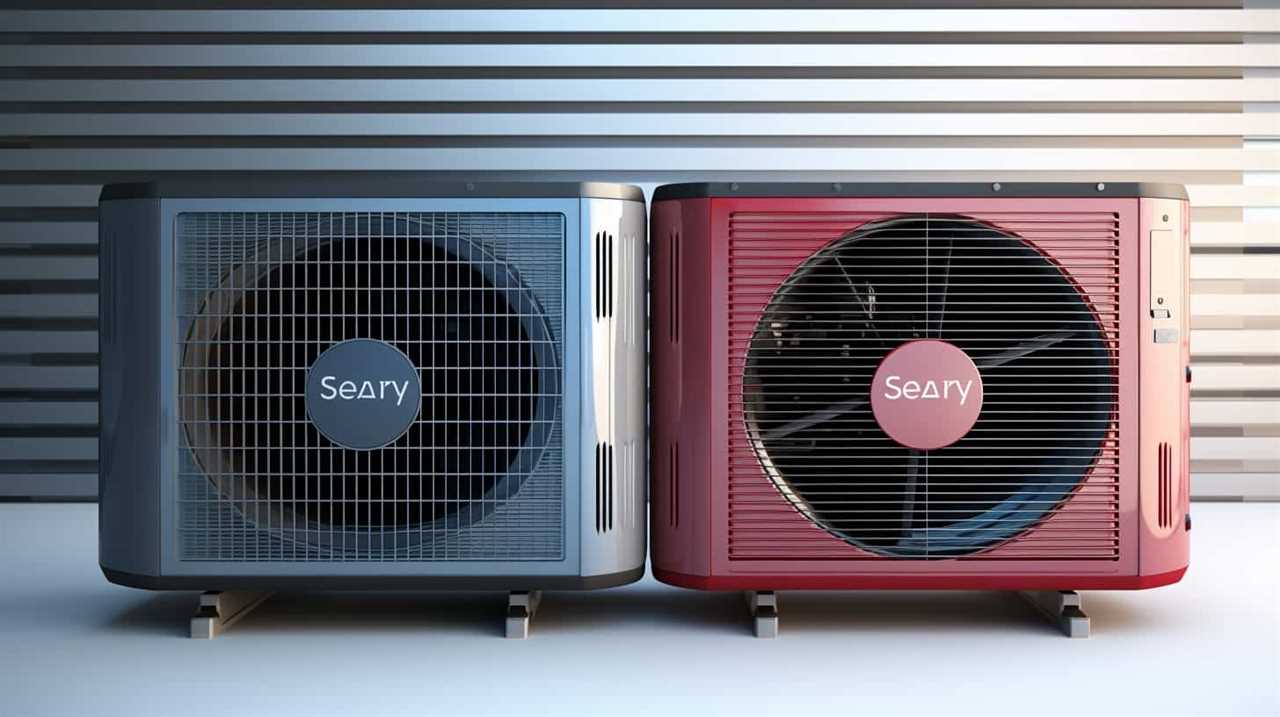
Can Heat Pumps Be Used in All Types of Climates or Are They More Suitable for Specific Regions?
Heat pumps can be used in all types of climates, but their efficiency may vary in extreme conditions. Some limitations include reduced performance in very cold regions and the need for additional heating sources.
Are There Any Government Incentives or Tax Credits Available for Installing Heat Pumps?
There are government incentives and tax credits available for installing heat pumps. These incentives can significantly reduce the upfront cost and make renewable energy more accessible to homeowners and businesses.
How Long Does It Typically Take for a Heat Pump to Pay for Itself in Terms of Energy Savings?
The heat pump payback period depends on various factors, including energy costs, climate, and insulation. It typically takes about 5-10 years for a heat pump to pay for itself in terms of energy savings.
Are There Any Maintenance Requirements or Recommended Practices to Ensure the Long-Term Efficiency of a Heat Pump?
To ensure long-term efficiency, heat pumps require regular maintenance and adherence to recommended practices. These include cleaning or replacing air filters, checking refrigerant levels, and inspecting electrical components. Neglecting these requirements can result in decreased performance and higher energy consumption.

Conclusion
In conclusion, renewable energy sources such as solar, geothermal, wind, biomass, and hydropower play a crucial role in boosting heat pump efficiency.
One interesting statistic to note is that harnessing solar energy can increase heat pump performance by up to 40%, while utilizing geothermal power can improve efficiency by up to 50%.
These renewable energy solutions not only provide sustainable alternatives to traditional heating methods but also contribute to a more energy-efficient and environmentally friendly future.
Thermal Energy Transfer
Decoding Heat Pumps’ Energy Efficiency Ratings: A Guide

Welcome to our guide on understanding the energy efficiency ratings of heat pumps! Have you ever been confused by the numbers and acronyms? We’re here to assist you.
In this article, we’ll break down the importance of energy efficiency ratings, how they’re calculated, and the key metrics to look out for.
We’ll also provide tips on maximizing your heat pump’s performance.
So, let’s dive in and uncover the secrets to choosing the most efficient heat pump for your needs.
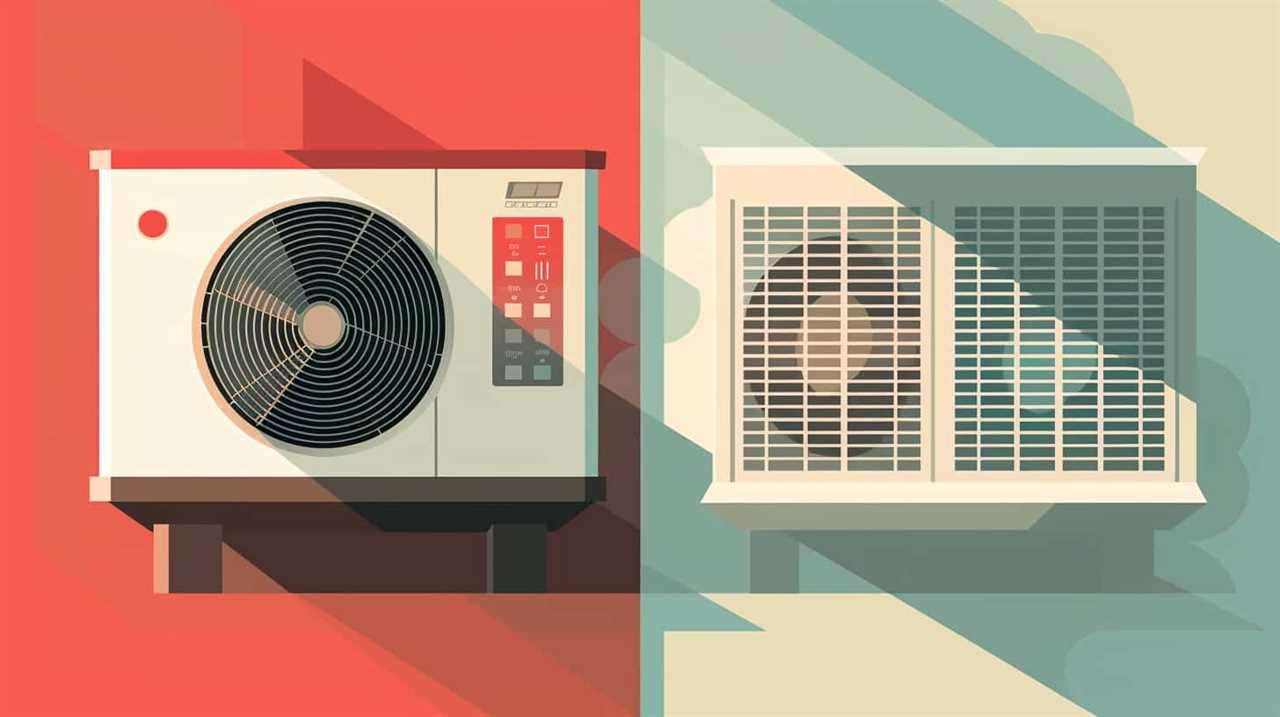
Key Takeaways
- Energy efficiency ratings are important in determining the effectiveness and cost savings of heat pumps.
- Higher efficiency ratings indicate lower energy consumption and can lead to reduced energy bills.
- Heat pumps with higher efficiency ratings often qualify for rebates and incentives.
- Evaluating energy efficiency ratings helps in making informed decisions and maximizing the benefits of heat pumps.
The Importance of Energy Efficiency Ratings in Heat Pumps
We believe that energy efficiency ratings play a crucial role in determining the effectiveness of heat pumps. When evaluating energy savings and long-term cost benefits, it’s important to consider the efficiency rating of a heat pump.
An energy efficiency rating provides a measure of how effectively a heat pump converts electricity into heat. Higher efficiency ratings indicate that the heat pump is more efficient in converting energy, resulting in lower energy consumption and ultimately, cost savings.
By choosing a heat pump with a high energy efficiency rating, homeowners can reduce their energy bills and minimize their environmental impact. Additionally, heat pumps with higher efficiency ratings often qualify for rebates and incentives, further enhancing the long-term cost benefits.
Evaluating energy efficiency ratings is therefore essential in making informed decisions and maximizing the benefits of heat pump technology.

How Energy Efficiency Ratings Are Calculated for Heat Pumps
To determine the energy efficiency rating of a heat pump, manufacturers use standardized testing procedures to measure its performance and calculate the ratio of heat output to electricity input. This calculation process takes into account various factors that affect the efficiency of the heat pump.
Here are some of the factors considered:
- Seasonal Energy Efficiency Ratio (SEER): This measures the cooling efficiency of the heat pump during the cooling season.
- Heating Seasonal Performance Factor (HSPF): This measures the heating efficiency of the heat pump during the heating season.
- Coefficient of Performance (COP): This measures the overall efficiency of the heat pump by considering both the cooling and heating modes.
Understanding SEER and HSPF: Key Energy Efficiency Metrics for Heat Pumps
SEER and HSPF are important energy efficiency metrics that help consumers understand the performance of heat pumps.
When it comes to evaluating the energy efficiency of heat pumps, it’s essential to understand the differences between SEER and HSPF ratings.

SEER, or Seasonal Energy Efficiency Ratio, measures the cooling efficiency of the heat pump. It calculates the amount of cooling output divided by the energy input over a cooling season. The higher the SEER rating, the more energy-efficient the heat pump is in cooling mode.
On the other hand, HSPF, or Heating Seasonal Performance Factor, measures the heating efficiency of the heat pump. It calculates the amount of heating output divided by the energy input over a heating season. A higher HSPF rating indicates better heating efficiency.
Both SEER and HSPF ratings are important when evaluating the energy efficiency of heat pumps. The choice between the two depends on the climate and the specific heating and cooling needs of the consumer. In warmer climates, where cooling demands are higher, SEER rating becomes more important. In colder climates, where heating demands are higher, HSPF rating is more significant.
To make an informed decision, it’s crucial to consider both SEER and HSPF ratings in order to choose a heat pump that meets your specific energy efficiency needs.

Comparing Energy Efficiency Ratings: What to Look for in Heat Pump Models
When comparing energy efficiency ratings, it’s important to regularly and carefully examine the different features of heat pump models. Here are three key aspects to consider when evaluating energy efficiency in heat pump models:
-
Seasonal Energy Efficiency Ratio (SEER): This rating measures the cooling efficiency of the heat pump. Look for a higher SEER rating, as it indicates better energy efficiency and lower operating costs during the cooling season.
-
Heating Seasonal Performance Factor (HSPF): HSPF measures the heating efficiency of the heat pump. A higher HSPF rating means better energy efficiency and lower heating costs during the heating season.
-
Energy Star Certification: Look for heat pump models that have earned the Energy Star certification. These models meet strict energy efficiency guidelines set by the Environmental Protection Agency (EPA) and can help you save on energy usage and costs.
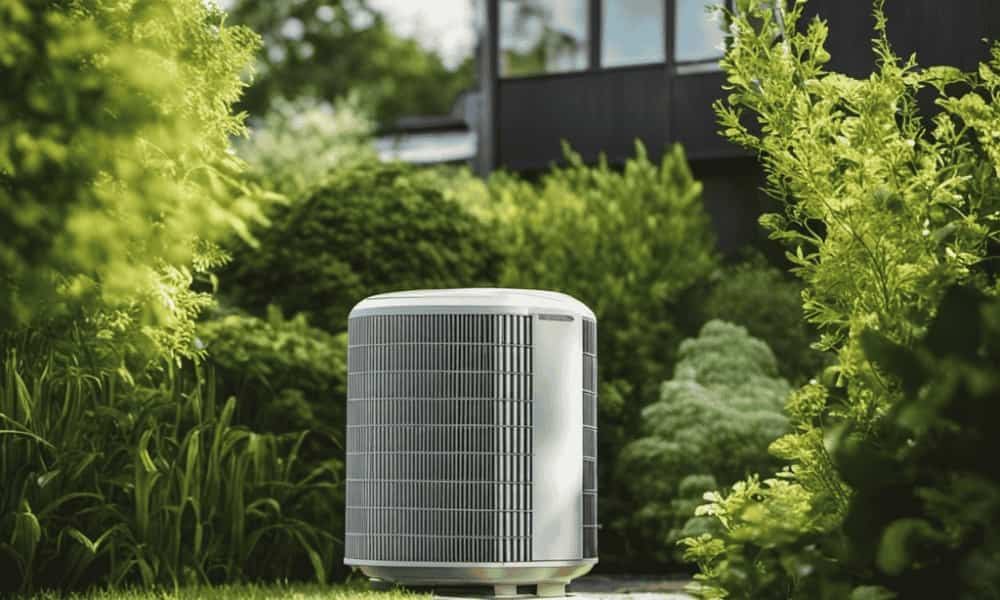
By considering these factors, you can make an informed decision when selecting a heat pump model that prioritizes energy efficiency.
In the next section, we’ll explore tips for maximizing energy efficiency and improving heat pump performance.
Maximizing Energy Efficiency: Tips for Improving Heat Pump Performance
To ensure that we get the most out of our heat pump and maximize its energy efficiency, we should implement these tips for improving its performance. First, regular maintenance is crucial for optimal operation. This includes cleaning or replacing air filters, inspecting and cleaning coils, and checking refrigerant levels. By keeping our heat pump in top condition, we can ensure that it operates efficiently and effectively. Additionally, optimizing the settings on our heat pump can make a significant difference in energy efficiency. Adjusting the thermostat to an appropriate temperature and utilizing programmable settings can help reduce energy consumption. It is also important to consider the size and placement of our heat pump, as these factors can impact its efficiency. By following these tips, we can improve the performance of our heat pump and save on energy costs.
| Tips for Improving Heat Pump Performance |
|---|
| Regular maintenance such as cleaning or replacing air filters, inspecting and cleaning coils, and checking refrigerant levels. |
| Optimizing settings on the heat pump, adjusting the thermostat to an appropriate temperature, and utilizing programmable settings. |
| Considering the size and placement of the heat pump to ensure maximum efficiency. |
Frequently Asked Questions
Are All Heat Pumps Required to Have an Energy Efficiency Rating?
Yes, all heat pumps are required to have an energy efficiency rating. Government regulations and industry standards mandate the inclusion of this rating to provide consumers with information about the product’s energy efficiency performance.

Can the Energy Efficiency Rating of a Heat Pump Change Over Time?
Yes, the energy efficiency rating of a heat pump can change over time due to various factors affecting efficiency. These factors include regular maintenance, age of the equipment, and advancements in technology.
How Can I Determine the Energy Efficiency Rating of My Existing Heat Pump?
To determine the energy efficiency rating of our existing heat pump, we can calculate the efficiency ratio by dividing the output heating or cooling energy by the input electrical energy.
Are There Any Government Incentives or Rebates Available for Purchasing a High-Efficiency Heat Pump?
Yes, there are government incentives and heat pump rebates available for purchasing a high-efficiency heat pump. These incentives and rebates can help reduce the cost and make it more affordable for homeowners to upgrade their heating systems.
Does the Location or Climate Affect the Energy Efficiency Rating of a Heat Pump?
In certain climates, heat pump efficiency ratings can be affected by the location. Additionally, proper installation is crucial for maximizing efficiency. These factors highlight the importance of considering climate and installation when evaluating a heat pump’s energy efficiency.

Conclusion
In conclusion, understanding energy efficiency ratings is crucial when evaluating heat pump options. By decoding SEER and HSPF metrics, consumers can make informed decisions that align with their energy-saving goals.
Comparing ratings and considering tips for maximizing efficiency ensures optimal performance.
Just as a skilled conductor coordinates an orchestra to create a harmonious symphony, homeowners who choose a heat pump with high energy efficiency ratings can enjoy a synchronized blend of comfort and cost savings.
Thermal Energy Transfer
Sustainable Home Design: Heat Pump Systems Efficiency Revealed
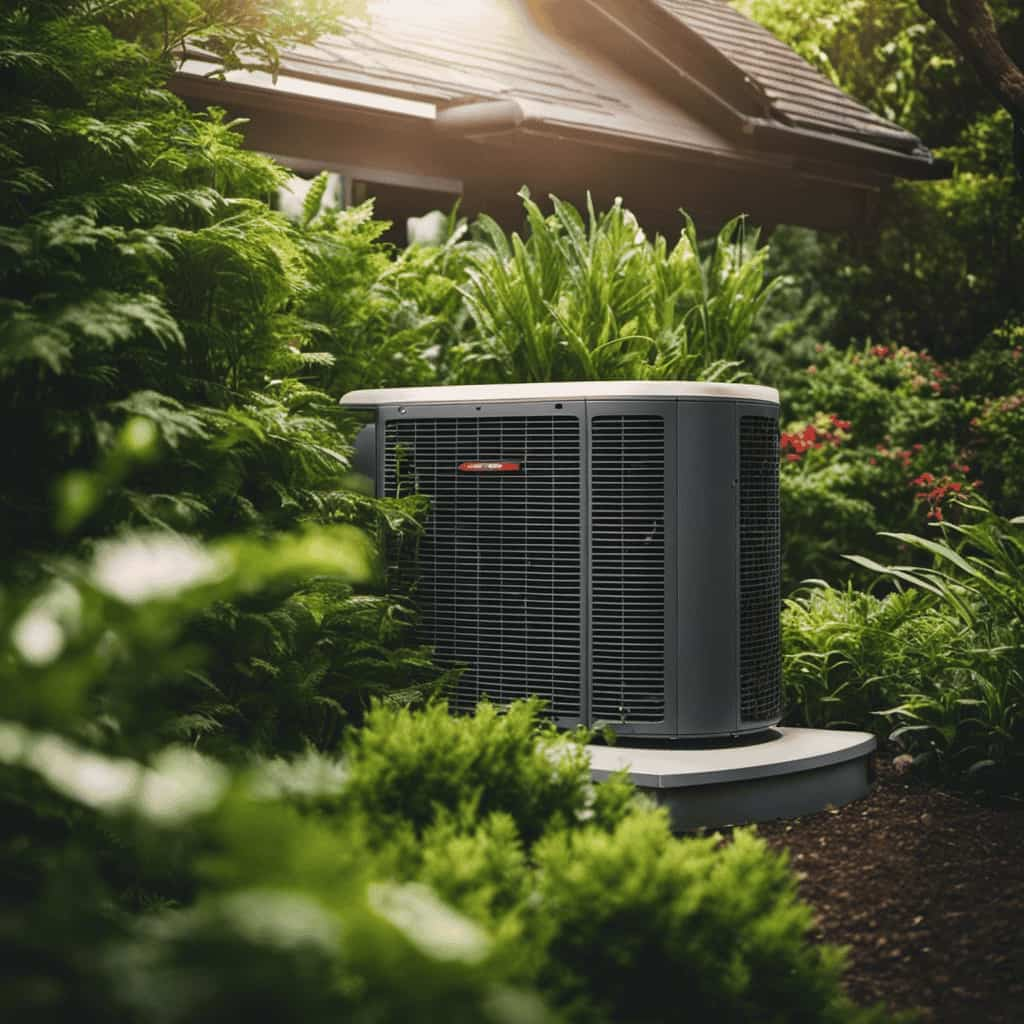
We believed we had a thorough understanding of sustainable home design, but our perspective changed when we learned about the impressive efficiency of heat pump systems.
In this article, we reveal the hidden benefits and secrets of these remarkable systems. From understanding energy efficiency ratings to tips for designing a sustainable home, we’ll guide you through the process of maximizing energy savings.
Prepare to be amazed by the innovations in heat pump technology that can transform your home into an eco-friendly haven.
Let’s dive into the world of heat pump systems and uncover their true potential.

Key Takeaways
- Heat pump systems significantly reduce energy consumption.
- Choosing a system with high SEER and HSPF ratings ensures maximum energy efficiency.
- Proper insulation and optimal system sizing are crucial for efficient heating and cooling.
- Regular maintenance helps maintain optimal system performance and energy efficiency.
The Benefits of Heat Pump Systems in Sustainable Home Design
One of the key benefits of heat pump systems in sustainable home design is that they can significantly reduce energy consumption. This advantage is especially important in today’s world, where energy efficiency is a top priority. By using heat pump systems, homeowners can lower their energy bills and reduce their carbon footprint.
Case studies have shown that these systems can achieve energy savings of up to 50% compared to traditional heating and cooling methods. Additionally, heat pump systems provide both heating and cooling capabilities, eliminating the need for separate systems and saving space.
They also offer precise temperature control and can be easily integrated with renewable energy sources such as solar panels. Overall, heat pump systems are a practical and efficient choice for sustainable home design.
Understanding Energy Efficiency Ratings for Heat Pump Systems
When it comes to understanding energy efficiency ratings for heat pump systems, we need to consider factors such as the Seasonal Energy Efficiency Ratio (SEER) and the Heating Seasonal Performance Factor (HSPF). These ratings are important in evaluating the performance of a heat pump system.

The SEER measures the cooling efficiency of the system during the cooling season, while the HSPF measures the heating efficiency during the heating season. Higher SEER and HSPF ratings indicate greater energy efficiency, which means lower energy consumption and cost savings.
It’s crucial to consider these ratings when choosing a heat pump system for your sustainable home. By opting for a system with high SEER and HSPF ratings, you can ensure maximum energy efficiency and reduce your environmental impact.
In the next section, we’ll discuss tips and considerations for designing a sustainable home with heat pump systems.
Designing a Sustainable Home With Heat Pump Systems: Tips and Considerations
To maximize the energy efficiency of our sustainable home, we should consider various tips and considerations when designing it with heat pump systems. Here are three key factors to keep in mind:

-
Proper insulation: Insulating your home effectively is crucial for reducing heat loss and ensuring that your heat pump system operates efficiently. Insulate walls, floors, and roofs to minimize heat transfer and maintain a comfortable indoor temperature.
-
Optimal system sizing: It’s important to choose the right size heat pump system for your home. Oversized systems can lead to inefficient operation, while undersized systems may struggle to meet your heating and cooling needs. Work with a professional to determine the appropriate size for your specific requirements.
-
Renewable energy integration: Consider integrating renewable energy sources, such as solar panels or wind turbines, with your heat pump system. This allows you to harness clean energy and further reduce your carbon footprint.
Maximizing Energy Savings Through Proper Heat Pump System Sizing
To maximize our energy savings, we need to ensure that our heat pump system is properly sized for our home. A heat pump that is too small will struggle to heat or cool our space efficiently, while a system that is too large will cycle on and off frequently, leading to increased energy consumption and wear and tear on the equipment. Proper heat pump sizing involves considering factors such as the size and layout of our home, insulation levels, and climate conditions. Consulting with a professional during the heat pump installation process is crucial to ensure accurate sizing. Additionally, regular heat pump maintenance, including cleaning filters and checking refrigerant levels, will help maintain optimal system performance and energy efficiency.
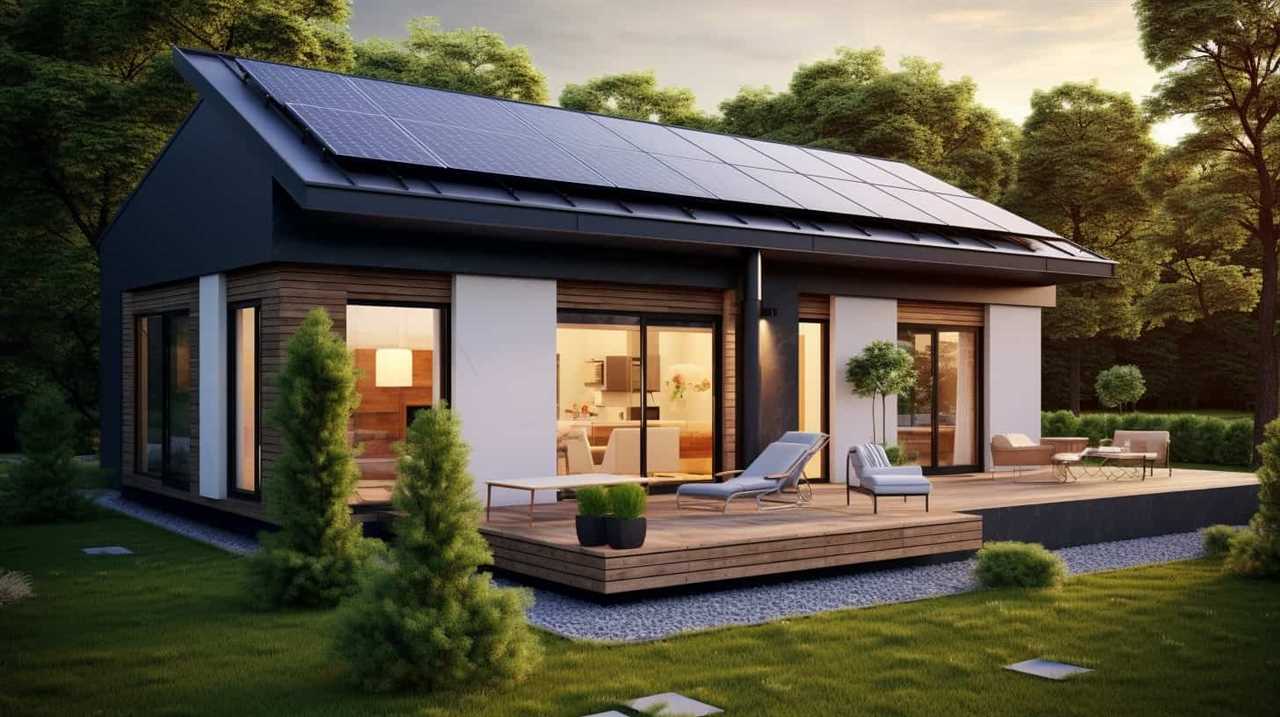
| Factors to Consider for Proper Heat Pump Sizing | |
|---|---|
| Size and layout of our home | Insulation levels |
| Climate conditions | |
| Consultation with a professional during installation | Regular heat pump maintenance |
Innovations in Heat Pump Technology for Sustainable Home Design
We have witnessed remarkable advancements in heat pump technology, revolutionizing sustainable home design. These innovations have brought about significant improvements in the efficiency and performance of heat pump systems, making them an increasingly attractive option for homeowners looking to integrate renewable energy sources into their homes.
Here are three key advancements in heat pump technology:
-
Variable speed compressors: These allow heat pumps to adjust their speed based on the heating or cooling needs of a home, resulting in more precise temperature control and increased energy efficiency.
-
Improved refrigerants: Newer heat pumps use environmentally friendly refrigerants that have a lower impact on the ozone layer and contribute less to global warming.

-
Smart controls and connectivity: Heat pumps now come equipped with smart thermostats and connectivity features, allowing homeowners to remotely control and monitor their systems, optimizing energy usage and reducing costs.
With these advancements, heat pump systems are now a reliable and efficient solution for sustainable home design, offering homeowners the opportunity to reduce their carbon footprint and save on energy bills.
Frequently Asked Questions
Are Heat Pump Systems Suitable for All Types of Homes, or Are There Specific Requirements?
Heat pump systems can be suitable for most homes, but specific requirements, such as adequate insulation and proper sizing, should be met. Consider heat pump system installation costs and the environmental impact when deciding on sustainability.
How Long Do Heat Pump Systems Typically Last Before Needing to Be Replaced?
Heat pump systems typically last around 15-20 years before needing replacement. Factors that affect their lifespan include proper maintenance, usage patterns, and the quality of the system’s components.
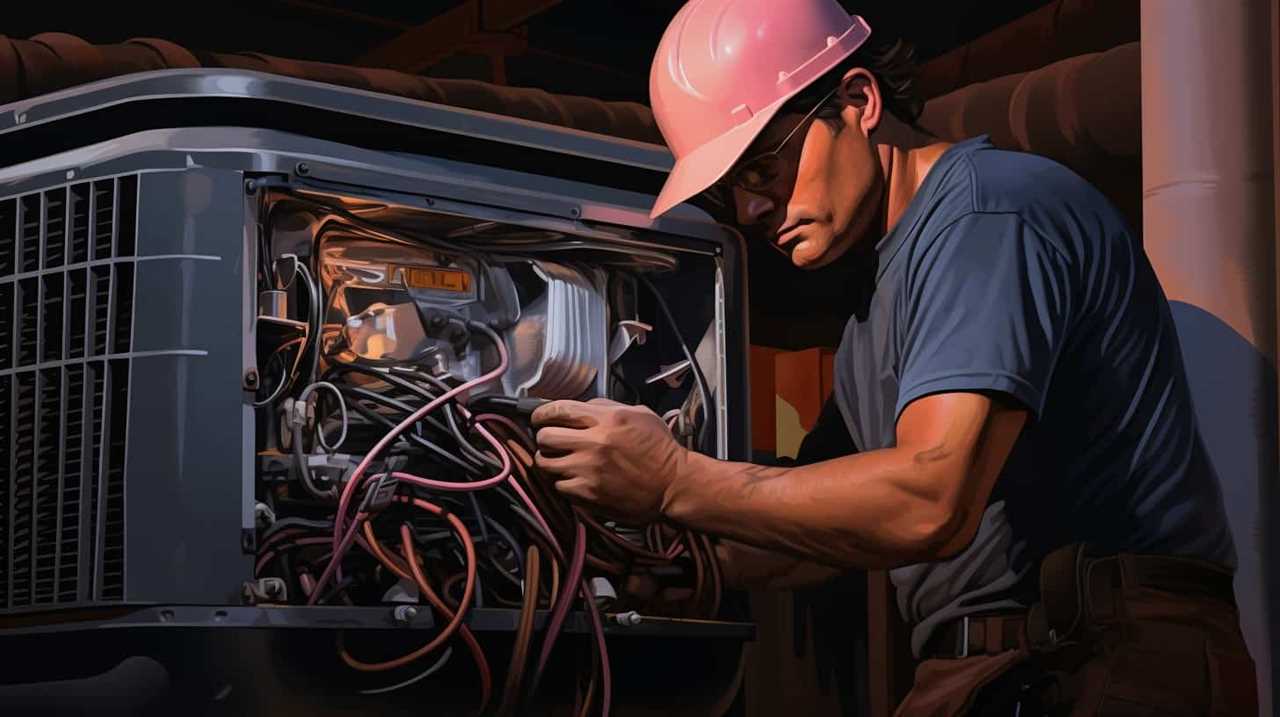
Can Heat Pump Systems Be Used for Both Heating and Cooling Purposes?
Yes, heat pump systems can be used for both heating and cooling purposes. They offer efficient temperature control in our homes. The benefits of using these systems include energy savings and a comfortable living environment.
Are There Any Government Incentives or Rebates Available for Homeowners Who Choose to Install Heat Pump Systems?
Government incentives and rebates are available for homeowners who install heat pump systems. These incentives are designed to encourage energy savings and make sustainable home design more accessible and affordable for everyone.
Are There Any Maintenance Requirements or Costs Associated With Heat Pump Systems?
Maintaining heat pump systems requires regular maintenance to ensure optimal performance. Costs associated with maintenance include filter replacements, annual inspections, and occasional repairs. However, these costs are outweighed by the long-term energy savings and environmental benefits.
Conclusion
In conclusion, heat pump systems are a symbol of efficiency and sustainability in home design.

Their energy efficiency ratings and innovative technology make them a practical choice for those seeking to reduce their environmental impact.
By properly sizing the system and considering tips for sustainable design, homeowners can maximize energy savings and create a comfortable living space.
So, let’s embrace the power of heat pump systems and build a greener future for our homes.
-

 Residential and Commercial Applications2 weeks ago
Residential and Commercial Applications2 weeks agoBest Amana Heat Pump Reviews
-

 Thermal Energy Transfer2 weeks ago
Thermal Energy Transfer2 weeks agoBreakthroughs in Modern Heat Pump Systems: Thermal Energy Edition
-

 Residential and Commercial Applications2 weeks ago
Residential and Commercial Applications2 weeks agoBest Heat Pump
-

 Geothermal Heat Pumps3 months ago
Geothermal Heat Pumps3 months agoUpgrade Your Comfort with Our Efficient HVAC Systems
-

 Air Conditioning3 months ago
Air Conditioning3 months agoExploring Energy-Efficient Air Conditioning Heat Pumps
-

 Geothermal Heat Pumps3 months ago
Geothermal Heat Pumps3 months agoInnovative Geothermal Heat Pump Manufacturers Revolutionize Energy Efficiency
-

 Thermal Energy Transfer1 month ago
Thermal Energy Transfer1 month agoBoost Your Heat Pump Efficiency: Interactive Guide
-

 Residential and Commercial Applications2 weeks ago
Residential and Commercial Applications2 weeks agoBest Portable Heat Pump Heat & AC










